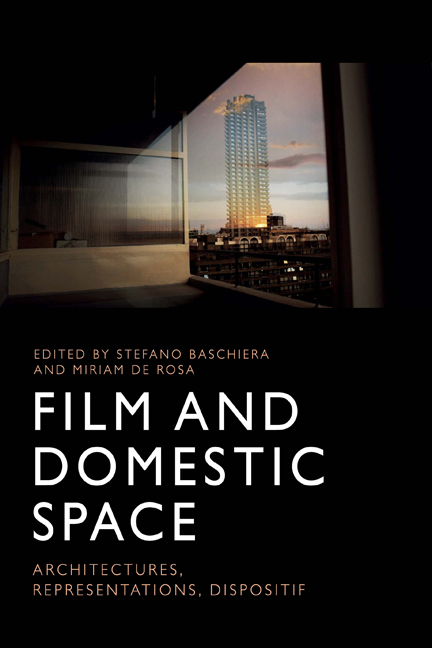Book contents
- Frontmatter
- Contents
- List of Figures
- Notes on the Contributors
- Acknowledgements
- Introduction
- 1 Architectures of Ubiquity: The Colonial Revival in Film and Television
- 2 No Down Payment: Whiteness, Japanese American Masculinity and Architectural Space in the Cinematic Suburbs
- 3 Resist, Redefine, Appropriate: Negotiating the Domestic Space in Contemporary Female Biopics
- 4 Liminal Spaces, Lesbian Desire and Veering off Course in Todd Haynes’s Carol
- 5 A Home on the Road in Claire Denis’s Vendredi soir
- 6 Acoustic Ectoplasm and the Loss of Home
- 7 Our House Now: Flat and Reversible Home Spaces in Post-war Film and Television
- 8 From Myth to Reality: Images of Domestic Space in Post-Soviet Baltic Films
- 9 No | Home | Movie: Essay Film, Architecture as Framing and the Non-house
- 10 At Home with the Nouvelle Vague: Apartment Plots and Domestic Urbanism in Godard’s Une femme est une femme and Varda’s Cléo de 5 à 7
- 11 Dwelling the Open: Amos Gitai and the Home of Cinema
- 12 What Is Cult When It’s At Home? Reframing Cult Cinema in Relation to Domestic Space
- 13 High-fructose Cinema and the Movie Industrial Complex: Radicalising the Technology of Representation in a Domestic Kind of Way
- Index
2 - No Down Payment: Whiteness, Japanese American Masculinity and Architectural Space in the Cinematic Suburbs
Published online by Cambridge University Press: 22 September 2020
- Frontmatter
- Contents
- List of Figures
- Notes on the Contributors
- Acknowledgements
- Introduction
- 1 Architectures of Ubiquity: The Colonial Revival in Film and Television
- 2 No Down Payment: Whiteness, Japanese American Masculinity and Architectural Space in the Cinematic Suburbs
- 3 Resist, Redefine, Appropriate: Negotiating the Domestic Space in Contemporary Female Biopics
- 4 Liminal Spaces, Lesbian Desire and Veering off Course in Todd Haynes’s Carol
- 5 A Home on the Road in Claire Denis’s Vendredi soir
- 6 Acoustic Ectoplasm and the Loss of Home
- 7 Our House Now: Flat and Reversible Home Spaces in Post-war Film and Television
- 8 From Myth to Reality: Images of Domestic Space in Post-Soviet Baltic Films
- 9 No | Home | Movie: Essay Film, Architecture as Framing and the Non-house
- 10 At Home with the Nouvelle Vague: Apartment Plots and Domestic Urbanism in Godard’s Une femme est une femme and Varda’s Cléo de 5 à 7
- 11 Dwelling the Open: Amos Gitai and the Home of Cinema
- 12 What Is Cult When It’s At Home? Reframing Cult Cinema in Relation to Domestic Space
- 13 High-fructose Cinema and the Movie Industrial Complex: Radicalising the Technology of Representation in a Domestic Kind of Way
- Index
Summary
This chapter examines the imbrication of spatiality, masculinity and race in the melodrama and social problem film No Down Payment (Martin Ritt, 1957), one in a cycle that explores the adverse forces that impinge on the mid-century cinematic suburbs. The cycle includes The Desperate Hours (William Wyler, 1955), Bigger Than Life (Nicholas Ray, 1956) and Crime of Passion (Gerd Oswald, 1957) among others that refer both overtly and obliquely to race and housing issues often because of the subjects they omit, films in which suburban homes are either under siege by undesirable others who ‘move in’ or ‘inhabit’ the domestic realm and are jettisoned in order to restore a provisional, normative, white suburban hegemony and insure private property. As Eric Lott asserts when discussing film noir – an assertion also applicable to the aforementioned domestic melodramas – the exclusion or marginalisation of others frequently prompts us to dismiss racial associations as coincidental or as the ruses of metaphor when ‘in fact such metaphorical ruses and the presence of black, Asian, or Mexican bodies confirm the central symbolic significance of color to the black-and-white world of many noirs’ (Lott 1997: 545). Extending Lott's analysis, I seek to recover such covert and overt racial themes, which displace the fear of minorities, the lower classes and others to a myriad of external and internal threats, especially the era's countless acts of the real, and what historian Arnold R. Hirsch refers to as the ‘hidden violence’ perpetrated against those who sought equal housing, especially in the white suburbs (Hirsch 1998: 40). I also examine the discrete experiences and representations of Japanese Americans seeking housing from those of other minority groups in cinema so as to avoid essentialising a generic raced other. With regard to real housing exclusions during the post-war period, African Americans and Japanese Americans shared the most reviled status behind Mexican Americans and Chinese Americans; the former were constructed as aggressive, overly sexual and criminal, while the latter were labelled inassimilable and disloyal, especially after Japan's attack on Manchuria (1931) and later, the bombing of Pearl Harbor (1941).
- Type
- Chapter
- Information
- Film and Domestic SpaceArchitectures, Representations, Dispositif, pp. 37 - 55Publisher: Edinburgh University PressPrint publication year: 2020



